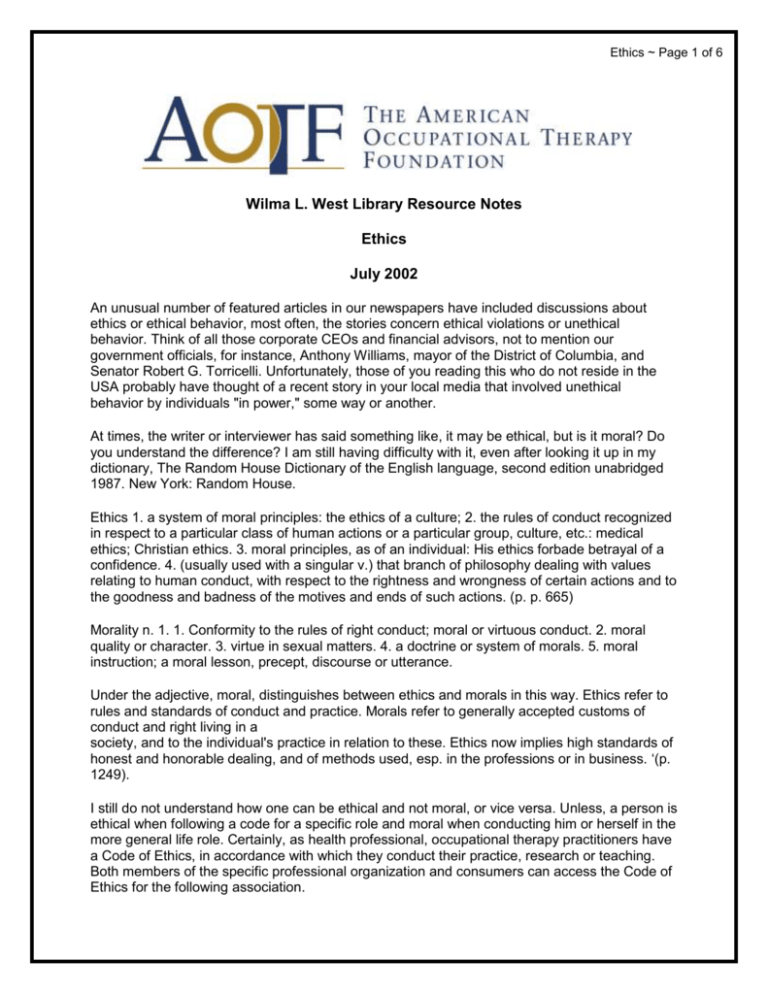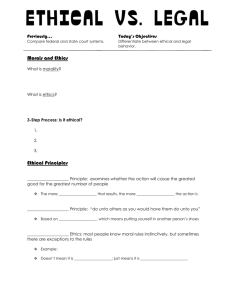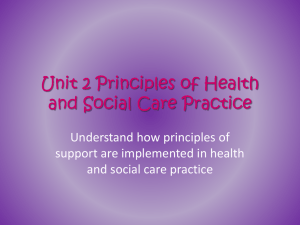Ethics ~ Page 1 of 6 Wilma L. West Library Resource Notes Ethics
advertisement

Ethics ~ Page 1 of 6 Wilma L. West Library Resource Notes Ethics July 2002 An unusual number of featured articles in our newspapers have included discussions about ethics or ethical behavior, most often, the stories concern ethical violations or unethical behavior. Think of all those corporate CEOs and financial advisors, not to mention our government officials, for instance, Anthony Williams, mayor of the District of Columbia, and Senator Robert G. Torricelli. Unfortunately, those of you reading this who do not reside in the USA probably have thought of a recent story in your local media that involved unethical behavior by individuals "in power," some way or another. At times, the writer or interviewer has said something like, it may be ethical, but is it moral? Do you understand the difference? I am still having difficulty with it, even after looking it up in my dictionary, The Random House Dictionary of the English language, second edition unabridged 1987. New York: Random House. Ethics 1. a system of moral principles: the ethics of a culture; 2. the rules of conduct recognized in respect to a particular class of human actions or a particular group, culture, etc.: medical ethics; Christian ethics. 3. moral principles, as of an individual: His ethics forbade betrayal of a confidence. 4. (usually used with a singular v.) that branch of philosophy dealing with values relating to human conduct, with respect to the rightness and wrongness of certain actions and to the goodness and badness of the motives and ends of such actions. (p. p. 665) Morality n. 1. 1. Conformity to the rules of right conduct; moral or virtuous conduct. 2. moral quality or character. 3. virtue in sexual matters. 4. a doctrine or system of morals. 5. moral instruction; a moral lesson, precept, discourse or utterance. Under the adjective, moral, distinguishes between ethics and morals in this way. Ethics refer to rules and standards of conduct and practice. Morals refer to generally accepted customs of conduct and right living in a society, and to the individual's practice in relation to these. Ethics now implies high standards of honest and honorable dealing, and of methods used, esp. in the professions or in business. ‘(p. 1249). I still do not understand how one can be ethical and not moral, or vice versa. Unless, a person is ethical when following a code for a specific role and moral when conducting him or herself in the more general life role. Certainly, as health professional, occupational therapy practitioners have a Code of Ethics, in accordance with which they conduct their practice, research or teaching. Both members of the specific professional organization and consumers can access the Code of Ethics for the following association. Ethics ~ Page 2 of 6 Canadian Association of Occupational Therapists NOTE: Please send me the site for those not here, and I'll add them to this is Even a casual searcher will find many articles in the occupational therapy journals addressing ethics and ethical caregiving. I searched MEDLINE to cull articles addressing the subject and published in non-OT Journals. Here is that list. Adamson BJ, Harris LM & Hunt AE. (1997). Health science graduates: preparation for the workplace. Journal of Allied Health, 2, 187-99. The research reported in this article was undertaken to assess the perceptions of health science graduates in the fields of health information management, occupational therapy, orthoptics, physiotherapy, and speech pathology regarding their perceptions of the adequacy of undergraduate preparation in meeting the demands of a changing health care environment. An instrument was devised for use by graduates on the basis of the skills and workplace behaviors specified by experienced practitioners in the above fields as necessary in newly recruited graduates. A total of 527 health science graduates completed the 52-item instrument. The statistical analyses indicated that 11 factors define the adequacy of graduates' preparation for the workplace. Health science graduates perceived themselves to have been more thoroughly prepared on certain workplace dimensions than on others. Specifically, graduates perceived themselves to be ill-equipped on dimensions concerned with workplace management, knowledge of the health industry, and coping in the workplace. Graduates also perceived themselves to be inadequately prepared in terms of communicating with clients, health professionals, and the general public. The strengths of their courses were perceived to be in completing essential tasks, having confidence in the clinical role, in ethical practice, in pursuit and application of knowledge, and having a realistic expectation of the workplace role. The results are discussed in terms of the need to address curriculum changes. Barnitt, R. (1998). Ethical dilemmas in occupational therapy and physical therapy: a survey of practitioners in the UK National Health Service. Journal of Medical Ethics, 24, 193-9. OBJECTIVES: To identify ethical dilemmas experienced by occupational and physical therapists working in the UK National Health Service (NHS). To compare ethical contexts, themes and principles across the two groups. DESIGN: A structured questionnaire was circulated to the managers of occupational and physical therapy services in England and Wales. SUBJECTS: The questionnaires were given to 238 occupational and 249 physical therapists that conformed to set criteria. RESULTS: Ethical dilemmas experienced during the previous six months were reported by 118 occupational and 107 physical therapists. The two groups were similar in age, grade, and years of experience. Fifty of the occupational therapy dilemmas occurred in mental health settings but no equivalent setting emerged for physical therapy. Different ethical themes emerged between the two groups, with the most common in occupational therapy being difficult dangerous behavior in patients and unprofessional staff behavior, and for physical therapists resource limitations and treatment effectiveness. No differences were found in the ethical principles used. CONCLUSION: The ethical dilemmas reported by the therapists were primarily concerned with Ethics ~ Page 3 of 6 health care ethics, rather than the more dramatic ethics reported in much of the biomedical ethics literature. Differences were found between the two professional groups when ethical contexts and themes were compared but not when ethical principles were compared. This suggests that educators and researchers need to be aware of work settings and the interdisciplinary nature of employment as well as ethical principles held by individual therapists. Barnitt, R & Partridge, C. (1997). Ethical reasoning in physical therapy and occupational therapy. Physiotherapy Research International, 2, 178-94. The purpose of the study was to describe and then compare ethical dilemmas reported by eight physical therapists and eight occupational therapists. A co-operative research method was adopted with the therapists participating in the analysis of the transcripts of the interviews. The analysis was carried out using a 'multiple' readings methods taken from hermeneutic phenomenology. Results showed that the context or setting of the dilemma had a major effect on the therapists' reasoning. Features which emerged from the context were the site of the dilemma, the work group, the patient group and the hierarchical or power relations in operation. Physical therapists and occupational therapists showed differences in reasoning style with the former more likely to adopt a diagnostic or procedural style, and the latter a narrative style. Dealing with ethical dilemmas was found to be a skilled and stressful aspect of practice. Capacity to deal with the dilemmas was negatively influenced by uncertainty of outcome, emotional sequelae of the event, and social pressure to behave in certain ways. Positive influences included previous experience with similar dilemmas, time for reflection, and support from peers. Bellner, AL. (1999). Senses of responsibility. A challenge for occupational and physical therapists in the context of ongoing professionalization. Scandinavian Journal of Caring Sciences, 13, 55-62. The aim of this paper was to delineate different senses of responsibility in the therapeutic relationship between occupational and physical therapists and their patients, in the context of ongoing professionalization. To assist the analysis of the therapists' responsibilities, Ozar's guild and interactive relationship models were employed. The questions with regard to each model asked how the model might be used in order to describe the therapists' professional development in general, and specifically their professional responsibilities. Based on earlier findings, the professional development of the therapy groups has developed in line with both the guild and interactive models, i.e. some therapists have adopted the former and others the latter. Whether therapists in general, in recent years, have shifted their paradigm, and consequently also their choice of relationship model, is a question that necessitates further research. However, based on the results from the analysis here, it seems relevant to propose that therapists, with a renewed sense of urgency, should use Ozar's models as tools for reflection on the development of their professional responsibilities in the therapist-patient relationship, in the frame of a rehabilitation paradigm. Brown, KH & Gillespie, D. (1997). "We become brave by doing brave acts": teaching moral courage through the theater of the oppressed. Literature & Medicine, 16, 108-20. Chiburis, L., Brown, K., Haddad, A. & Coppard, B. (1997). Ethics and rehabilitation of the patient with severe burns. Journal of Burn Care & Rehabilitation, 18, 443-6; discussion 441-2. Ethics ~ Page 4 of 6 In the case we present, a physician's order for the treatment of a patient with severe burns unfolds into an ethical dilemma for an occupational therapist. Several conflicting thoughts-in terms of the appropriateness and plan for treatment, while trying to maintain the patient's best interest as the central focus-come to mind. We examine the therapist's ethical responsibilities in light of considerations of futility, nonmaleficence, financial costs, and team relations. Several options for responding to the case are suggested. Levine, RE. (1983). A historical perspective on professional values. Journal of Allied Health, 12, 183-91. This article demonstrates the use of historical research to improve present allied health practice. The relationship between social values and the emergence of occupational therapy during the progressive era (1890-1920) is explored. This energetic period of history provided an opportunity for physicians to assume social, moral, and scientific leadership in a society that longed for expert solutions to complex social problems. At the turn of the century, occupational therapy, physical therapy, medical social work, and speech therapy all expanded the influence of the physician's expertise. Occupational therapy was originally developed to care for chronically impaired individuals. The relationship established between the physician and the therapist over 75 years ago still influences the status of both professions today. Luboshiysky, D. & Weil, F. (1993). Ethical and moral dilemmas in the treatment of an abusive parent--the occupational therapy perspective. Medicine & Law, 12, 221-7. Treating patients who physically abuse their children creates in the therapist moral and ethical dilemmas which challenge his or her ability to maintain a professional conduct and attitude. In such cases the therapist usually finds himself or herself confronted with the following dilemmas: (a) treatment of a patient who experiences therapy as a no-choice situation; (b) treatment of a patient whose conduct is in conflict with the moral values of the therapist; (c) the obligation of the therapist to report the abusive acts to the authorities versus his or her duty to protect the patient's right to confidentiality; and (d) the therapist's loyalty to the patient's welfare, when it is in conflict with the abused person's welfare. These issues are illustrated through the following case study examined in the context of occupational therapy (OT): A 26-year-old married woman, mother to a four-month-old infant was referred to therapy after causing severe burns to her daughter's hands. As a child the patient experienced physical abuse by her parents. The patient viewed treatment as her only possible means of keeping her child. On the other hand, she was suspicious of verbal therapy, as she assumed that the contents might incriminate her. Occupational therapy was therefore a major therapeutic modality used to assess and improve her \disturbed psychosocial occupational performances. The article describes the way in which the OT approach helped overcome and resolve the moral and ethical dilemmas raised in the case. Manhal-Baugus M. (2001). E-therapy: practical, ethical, and legal issues. Cyberpsychology & Behavior, 4, 551-63. E-therapy is a term that has been coined to describe the process of interacting with a therapist online in ongoing conversations over time when the client and counselor are in separate or remote locations and utilize electronic means to communicate with each other. It is a relatively new \modality of assisting individuals resolve life and relationship issues. E-therapy utilizes the power and convenience of the Internet to allow simultaneous (synchronous) and time-delayed (asynchronous) communication between an individual and a professional. For the purposes of Ethics ~ Page 5 of 6 this paper, e-therapy is defined as a licensed mental health care professional providing mental health services via e-mail, video conferencing, virtual reality technology, chat technology, or any combination of these. It does not include self-help methods such as public bulletin boards or private listservs. E-therapy is not psychotherapy or psychological counseling per se since it does to presume to diagnose or treat mental or medical disorders. However, e-therapy is flexible enough to also address many difficulties which clients present to the online therapist. As in other types of therapy, such as bibliotherapy, occupational therapy, and rehabilitation therapy), e-therapy does assist a person in addressing specific concerns with specific skills. This article examines the following issues of e-therapy. First, the types of e-therapy and related services are described to provide a background for the article. Second, the ethical codes which have been adopted by three major professional organizations (American Counseling Association, National Board for Certified Counselors, and the International Society for Mental Health Online) pertaining to e-therapy are summarized for professional and consumer use. Finally, the practical, ethical, and legal issues of e-therapy services are discussed fully. Mukand, JA. (1991). Human immunodeficiency virus infection and diffuse polyneuropathy. Implications for rehabilitation medicine. Western Journal of Medicine, 154, 549-53. Patients at various stages of human immunodeficiency virus (HIV) infection require rehabilitation services. These patients’ present problems for each of the disciplines in a rehabilitation team, and all team members must confront the psychosocial and ethical issues involved with the disease. Patients with HIV infection may have polyneuropathy with multisystem involvement, including dysphagia, autonomic dysfunction, respiratory failure, bowel and bladder dysfunction, generalized weakness, a painful sensory neuropathy, and depression. Guidelines are presented for determining if inpatient rehabilitation or other settings are appropriate. Case management is a valuable strategy for the rehabilitation of patients with this complicated disorder. Purtilo, RB. (1978). Ethics teaching in allied health fields. The Hastings Center Report, 8, 14-6. Sachs, D. (1993). Caring in the health care professions--a moral or a professional stand: perceptions of caring of female occupational therapists. Medicine & Law, 12, 241-7. This article presents research that explores how female occupational therapists define and experience their professional caring role. The research analyses the relation between female occupational therapists' self-perception, their moral stand and their professional behavior as patients' advocates. Caring for others, helping people in need, being responsible for the good of others; these and other calls of duty have been a major theme in defining the roles of occupational therapists as well as of other health care professionals. In the present study, seven female occupational therapists from the New York metropolitan area participated. For the collection of the data the researcher interviewed each of the participants, using in-depth ethnographic interviews. From the research main theme named 'self-perception as a caring person', four sub-themes were identified: (a) the perception of being a caring person; (b) being a caring person leads to becoming an occupational therapist; (c) being available to patients; and (d) protecting and helping patients. In this article the first three sub-themes are briefly described. The focus is on the fourth one. It analyses how the interviewees' self-perceptions as caring individuals are central to their moral decision-making Ethics ~ Page 6 of 6 process and to their involvement in patients' advocacy as part of their role and functions in occupational therapy. Compiled by Mary Binderman, MLS, Director of Information Resources, American Occupational Therapy Foundation, Bethesda, MD







